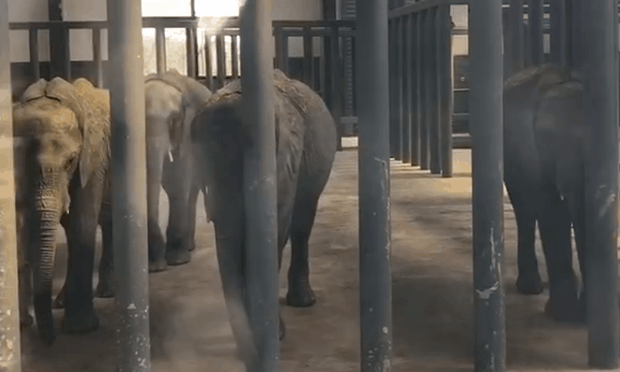
More than 30 young elephants were taken from the wild in Zimbabwe last year and flown to China for a life in captivity. Some of the elephants were as young as just three years old, according to reports, and once they reached China they were separated and taken to various zoos around the country including Shanghai Wild Animal Park, the Beijing Wildlife Park and the Hangzhou Safari Park. Many people have wondered and worried about what their innocent lives have been turned into, and now some information has been revealed through photos and video footage of their current state. Earlier this week, 12 of the calves went on show at the Shanghai park, who claim that the average age of the elephants is just four years old. After reviewing the photos, vice-chair of the Elephant Specialist Advisory Group of South Africa, Yolanda Pretorius, commented,
“Overall their body condition seems to be slightly below average but it does not look as if they are starving. One of the elephants has temporal gland secretions and I am not sure whether this is a good or bad sign. In the wild, elephants mostly secrete from their temporal glands when they get excited.”
Together with this, photos and video footage have also recently emerged showing the elephants in Hangzhou, which reveals that they are behind bars and walking on concrete floors. These images were obtained by the animal welfare advocate Chunmei Hu, former secretary general of the Chinese Green Development and Endangered Species Fund. Joyce Poole, co-founder of the Kenya-based Elephant Voices and renowned specialist on elephant behavior, was one of the many elephant experts who reviewed the video. She said, “They appear rather listless. Perhaps waiting for something but without much attention… Their housing is totally unstimulating. They look like sad, locked-up little kids.”
There is currently no official evidence that states how many elephants were sent to each zoo, together with very little evidence to show the current health and conditions of the once-wild elephants, although conservationists believe that 17 of the calves ended up in Shanghai, 15 in Beijing and six in Hangzhou. Iris Ho, the wildlife campaign manager at Humane Society International, said, “It is heartwrenching not knowing the current fate of these animals. It’s like knowing that someone – or children in this case, since they are baby elephants – is in danger or trapped in misery for the rest of their lives but there is nothing you can do about it.” Although owners of captive elephants are supposed to register births, deaths, trade and movements, these rules are not enforced, meaning that it is often only carried out on voluntary compliance unless it is necessary for the interest of the owner.

Despite the unethical practice of taking elephants from the wild and keeping them in concrete-floored cells, this live trade in elephants does not receive much attention compared to the ivory trade, simply because it is a legal practice, as sanctioned by Cites, the Convention on the International Trade in Endangered Species. There is no independent body that looks into the lives of the traded animals once they are captured and exported. Whilst Cites states that animals must be sent to “appropriate and acceptable destinations”, it is up to the importing country’s scientific authority to decide what is “appropriate and acceptable”.
Keith Lindsay, a collaborating researcher with the Amboseli Trust for Elephants in Kenya, said, “There currently is under Cites no independent, objective mechanism of oversight or monitoring of the welfare conditions of elephants (or any animals) when they enter the live export chain.” There are no minimal welfare standards and Lindsay says, “If both countries say they are happy with the welfare aspects of the trade, no matter how genuinely inadequate, there is nothing anyone else can say. The animal’s new destination “should replicate in every way the conditions of the native ecosystem, and there should be no impacts on the populations from which the animals are taken.”
During the most recent Cites conference in Johannesburg last year, there was an effort to stop the live trade in elephants, led by the African Elephant Coalition, a group of 29 African nations. However, China, the EU, the US and Zimbabwe did not support the resolution and it failed to gain the necessary two-thirds majority to pass into law.
Efforts by The Guardian to ask Zimbabwean and Chinese Cites authorities about the current condition of the elephants recently shipped to China was met with no response.


